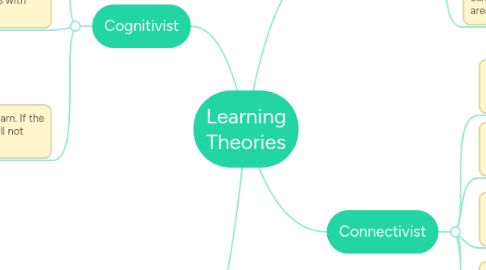
1. Constructivist
1.1. Learners are people who want to interact, are the centre of learning, and are active rather than passive.
1.1.1. Project-Based Learning
1.1.1.1. Learners incorporate hands-on interactions with their peers to complete a given project. Learners have to think critically and have to be able to problem solve.
1.2. Learning revolves around higher order thinking skills, collaborative and cooperative learning, and personal meaning and community
1.2.1. Infographics
1.2.1.1. Students create visual graphic representations of information. Ex: A graphic that shows the different types of Dating in Retail Mathematics
2. Cognitivist
2.1. Learners need to perceive and attend to information so that their knowledge can be transferred to working memory
2.1.1. Perceiving
2.1.2. Processing
2.2. Learners need given information to be chunked to prevent overload during processing in working memory. Information maps should be used to help learners with deep processing.
2.2.1. Linear Information Map
2.2.2. Spider-shaped Information Map
2.2.3. Hierarchical Information Map
2.3. Learners should be motivated to learn. If the learners are not motivated, they will not learn.
2.3.1. Intrinsic motivation
2.3.2. Extrinsic motivation
2.3.3. ARCS model (Attention, Relevance, Confidence, Satisfacation)
3. Behaviorist
3.1. Learners should be told outcomes of what they are learning so they can set expectations
3.2. Learners need to be regularly tested to check their achievement level on a given topic such as mathematics
3.3. Learners must be given feedback so that they can monitor how they are doing and focus on areas that need improvement
4. Connectivist
4.1. Learners should be allowed to explore and research current information by use of the Internet
4.2. Learners need to unlearn old information and learn current information.
4.3. Learners need to recognize important versus unimportant information.
4.3.1. Protecting Your Digital Tattoo
4.3.1.1. Learners need to stay aware of important areas such as personal information security, plagiarism, and cyber bullying so that they can protect themselves.
4.4. Learners need to be updated in their fields and need to be active participants in networking
4.5. Learners must be willing to acquire new knowledge on an ongoing basis
4.5.1. Creating Your Digital Toolbox
4.5.1.1. Learners should be able to acquire new knowledge about available digital tools that they can use in their current professions. Examples include VoiceThread, Kahoot, and Google Forms.

